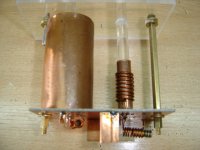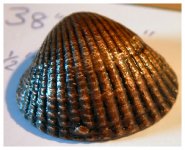Do anybody know any good recipe for copper plating using copper sulfate and sulfuric acid? I ask about concentrations and current densities used by you, and if the result was satisfactory.
Osvaldo.
Many thanks in advance.
Osvaldo.
Many thanks in advance.
It all depends on the material and its scope to cover. The process is not fast, but not complicated.
Thanks for the reply. I did copper plating in the chemistry classes in the school, and in my house, but nothing serious. But now, I want to re-copper copper, say, to get an layer of electrolytic copper of lower resistance in a copper plate and tubing to make a coil shield. Shields, and non magnetic cores (for permeability tuning in my case), tend to lower the Q of the tuned associated circuits as the conductivity is poor. Then putting a layer of good copper over the copper shields lowers the resistance and increases Q.
Attachments
I correctly understand the need copper layer on a copper screen, but with a lower current conductivity? If so, it can be made easier having put a layer of chromium or zinc.
No, the layer must have higher conductivity or lower resistivity, both the same thing. It is usual to use silver plating, but it is too expensive for only a test.
If you want high-quality coating of copper dense and crumbly.
Then:
copper sulfate - 60 – 80 g/l
Sulfuric acid - 180 – 200 g/l
Sodium chloride - 30 mg/l
The current density of 1 A to start and gradually rising to 4 A.
Then:
copper sulfate - 60 – 80 g/l
Sulfuric acid - 180 – 200 g/l
Sodium chloride - 30 mg/l
The current density of 1 A to start and gradually rising to 4 A.
Only copper will still be oxidized. To maintain high conductive copper, should be covered silver. Silver passivation protects against oxidation.
---
Oh God, why so long... long... long... loading comments?
---
Oh God, why so long... long... long... loading comments?
The surface of the copper plate donating species must be 2-3 times longer covered area. Plates place on all sides which should be covered with copper. Watch out for the coating color. If there is browning, lower amperage. Selection of the initial current determined by the current dissipation in elektorolite and metal. First, make a trial test. Better slow, but qualitatively.
OK, yes, I agree this concepts. I read somewhat that suggest to initially reverse the cell (Object piece in the anode) so initial corrosion make the future cathode to be cleaned inside the cell, and to use an anode filter coating to reduce liquid contamination from anode particles. Do you agree?
No. Strongly opposed. With this method there is the internal deformation and burn-out. Small gaps are formed in the metal structure.
--
Better before working material omit in sulfuric acid for 1-2 seconds.
--
Better before working material omit in sulfuric acid for 1-2 seconds.
Errata:
Sorry, I must write somewhere.
I read somewhat that ...
Sorry, I must write somewhere.
Ok.
Instead of sulfuric acid can be used another method of cleaning the surface. Applying corrosion inhibitor - thiourea. The composition of 30-50 g / l. Just a short dive.
Instead of sulfuric acid can be used another method of cleaning the surface. Applying corrosion inhibitor - thiourea. The composition of 30-50 g / l. Just a short dive.
There may be several reasons. When the coating of complex shapes with texture are often defective. Perhaps in the electrolyte or electrolyte impurities were contained many copper sulfate. When the cover is not the copper surface (coated graphite), the current start almost from scratch. You can also add organic inhibitors for the coating uniformity. For example, gelatin, 0.1 - 0.2 g / l.
Several years ago when in second school, I get a layer of pure iron over an aluminium bar using ferrum sulfate in water. As soon as it wet, it get the red color of the oxidized iron. Only "per jodere".
- Status
- Not open for further replies.
- Home
- Design & Build
- Construction Tips
- Copper plating with acid copper sulfate.

